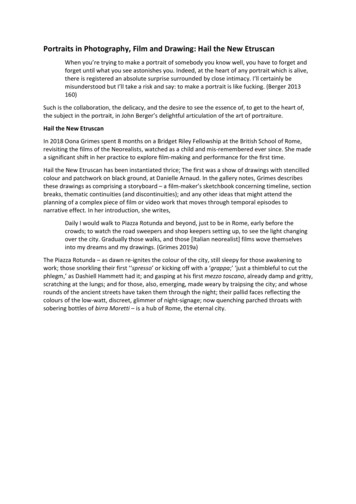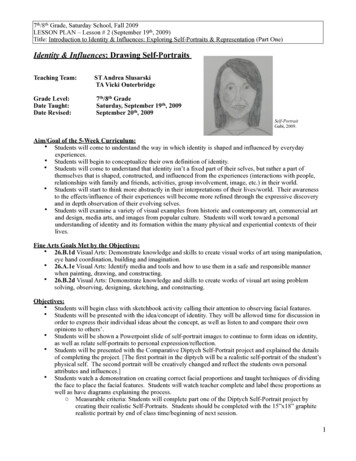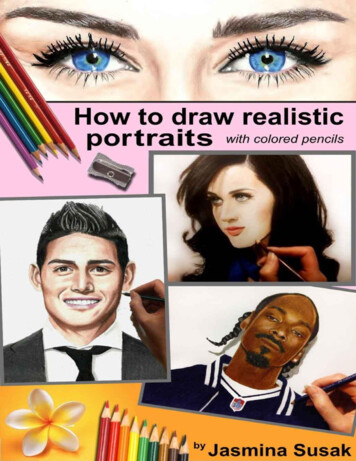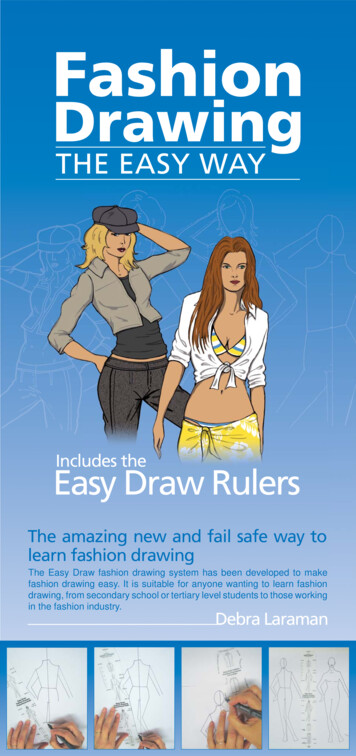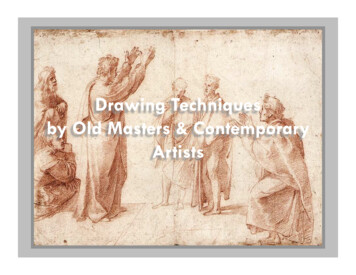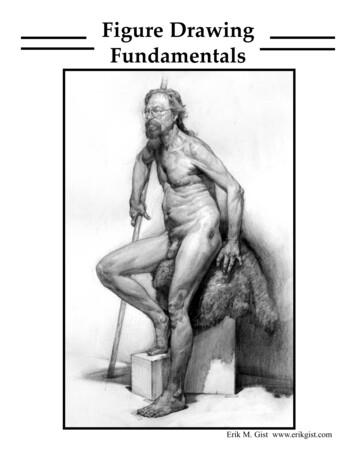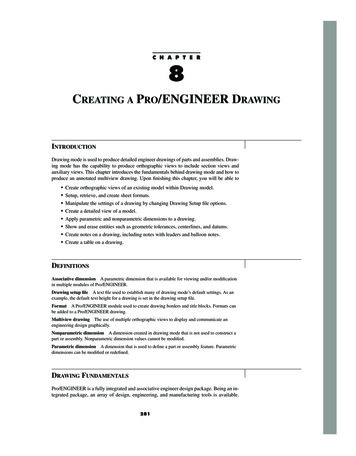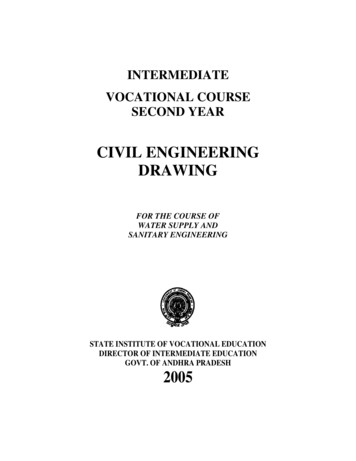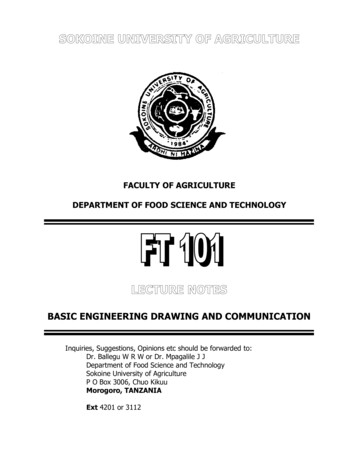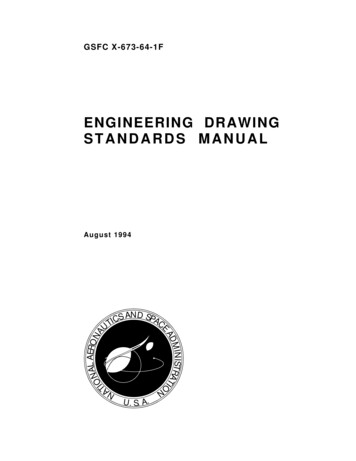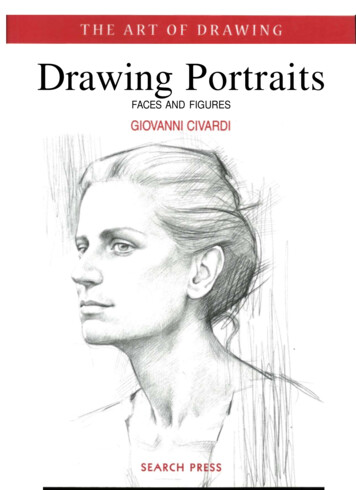
Transcription
Drawing PortraitsFACES AND FIGURES
THE ART OF D R A W I N GDrawing PortraitsFACES AND FIGURESGiovanni CivardiSEARCH PRESS
First published in Great Britain 2002 by Search Press Limited,Wellwood, North Farm Road, Tunbridge Wells, KentTN2 3DROriginally published in Italy 1994 by II Castello CollaneTecniche,MilanoCopyright II Castello CollaneTecniche, Milano 1994English translation by Julie CarbonaraEnglish translation copyright Search Press Limited 2002All rights reserved. No part of this book, text, photographs orillustrations may be reproduced or transmitted in any form or byany means by print, photoprint, microfilm, microfiche,photocopier, internet or in any way known or as yet unknown, orstored in a retrieval system, without written permission obtainedbeforehand from Search Press.ISBN 1 903975 09 3Design by Grazia CorteseThe portraits in this book were done with the models' agreement:any resemblance to other people is incidental.
INTRODUCTIONA portrait is commonly perceived as the representation of a humanbeing's features, whether the face, head and shoulders or the wholebody. It has always been an important theme in figurative arts and afavourite with artists, who have found in it, not just a professionalgenre well rewarded and socially appreciated for its symbolic orcelebratory value, but also an interesting opportunity to investigatethe human condition in its physical and, most of all, psychologicalaspect. It is this latter aspect which tends to predominatenowadays, as photography has greatly undermined the function ofthe drawn and painted portrait as the only way to reproduce andhand down for posterity an individual's physiognomic features.But this 'documentary' aspect was, of course, only one of thefeatures of the artistic portrait.Using my experience as a portrait painter, illustrator and teacher,I have tried to simplify and sum up the main problems one usuallycomes across when first tackling a 'generic' head drawing and,subsequently, an actual portrait or likeness. Some subjects ofparticular importance, e.g. drawing hands, portraits of children andelderly people, the full figure portrait, and heads with unusualfeatures have to be dealt with in more detail and are covered inmore advanced books.I have divided the short chapters and the accompanyingsketches according to a sequence which I have found of practicalhelp in teaching the rudiments of portrait 'technique'. I have foundthis approach quickly leads to satisfying results. The book coverstools, techniques, practical considerations, anatomy, details of theface, composition, lighting and actual method, stressing the'overall' view of the head.These basic technical principles can only direct you in your firstexperiences and should be seen as suggestions on which to buildyour own study. Your subsequent artistic development will dependon how committed you are to observation and how regularly youpractise drawing. To this purpose, you can, when you approachyour first drawings resort to observing drawings done by otherartists and taking photographs of your subject. However, as soon asyou feel confident in sketching the basic outlines of the head,I advise you to try and draw from life, getting a patient friend to sitfor you. In the last section of this book I have put together someportrait studies which I have drawn at different times and whichgive an indication of how to go about tackling different subjects.
TOOLS A N D TECHNIQUESYou can draw a portrait using any of the popular media: pencil, charcoal, pastel, penand ink, watercolour, felt-pen, etc. Each one of them, however, will produce differenteffects, not only due to the specific characteristics of the medium and the techniqueused, but also in relation to the characteristics of the surface on which it is drawn:smooth or rough-textured paper, card, white or coloured paper, etc. The drawings shownon these two pages demonstrate how different media effectively render the complextonal values of the human face and body.Pen and black Indian ink on smooth paperInk is widely used by artists. It can be appliedeither with a brush or with a pen, but specialeffects can be achieved using bamboo reeds,large nibs, fountain pens, technical pens,felt-pens, or ball-point pens. Tones can usually begraded by drawing more or less dense lines overone another at right angles (cross-hatching). It isadvisable to draw on smooth, good quality paperor card, so that the surface won't fray or absorbink irregularly.Pencil (B and 2B) on rough-textured paperPencil is the most widely used medium for anytype of drawing and, in figures and portraits,it allows you to be spontaneous and isconvenient to use. It can be used for verycomplex drawings or for small studies and quickreference sketches: for the latter very fine leadsare suitable, while for the former you can usethicker and softer-grade graphites. Graphites(leads that are held in mechanical, clutchpencils) as well as pencils (wood-encasedgraphites) are graded according to theirconsistency: from 9H, the hardest, which tracesthin and faint lines, to 6B, very soft, which tracesthick and dark lines with ease.4
Compressed charcoal on paperCharcoal is perhaps the ideal medium for portraitstudy as it is very easy to control when applyingtones but also allows you to achieve fairly sharpdetail. It should, however, be used 'broadly',concentrating on the overall rendering of the'shapes': this exploits its greatest assets, as it isboth versatile and evocative. You can use eithercompressed charcoal or willow charcoal but becareful, in either case, not to smudge the sheet.Charcoal strokes can be blended and smudged bygently rubbing with a finger, and tones can besoftened by blotting with a soft eraser (kneadableputty eraser). The finished drawing should beprotected by spraying with fixative.Monochromatic watercolour on medium-texturedpaperWatercolours, water-soluble inks, andwater-diluted Indian ink are ideal for portrait study,although they are closer to painting than todrawing, as they are applied with a brush andrequire a tonal vision which is both concise andexpressive. For quick studies you can usewater-soluble graphites or colour pencils (to blendstrokes easily, wipe them with a water-soakedbrush) and it is advisable to use heavy card so thatthe moisture will not cause the surface to cockleand become irregular.Pen and ink, watercolour, white pastel oncoloured paper'Mixed' media involves using different materialsto achieve a drawing with unusual effects.Although still 'graphic' materials, their morecomplex application requires good control and agood knowledge of the media themselves if weare to avoid muddled results of little aestheticmeaning. Mixed media are very effective ontextured and coloured, or dark, supports.
PRACTICAL ADVICEIt is useful to outline very briefly someadvice on portrait 'practice'. In thesubsequent chapters some of thesesubjects will be developed with the helpof diagrams and graphic examples.TYPES OF PORTRAITGiven the great variety of poses ahuman being can take on and thepsychological wealth whichcharacterizes every personality, theartist has to assess what 'pose' tosuggest to the model so that theseelements are displayed in the mostsuitable way to achieve a likeness.In addition, all individuals havetheir own characteristic posture andtypical movements which are part oftheir 'being'. On the other hand, thereare elements of physical behaviourand social convention which allow usto place the subject in the professionand 'status' they belong to or aim for.One can therefore differentiatebetween two types of portrait:'formal', where the subject's posefollows traditional patterns, and wherea lot of attention is paid tocomposition, the environment and the,at times symbolic, decor; and'informal', where the model's pose isspontaneous as he or she is captured ina casual pose or while carrying outsome regular activity in a normalenvironment. It is an effective andmodern way of portraying peoplewhich is a legacy of 'instant'photography and requires a lot of skilland good taste from the artist. To thiscategory belong also 'expressive'portraits, that is those where thesubject is, for instance, caught smilingor in motion.monotonous. Avoid dispersing thevisual interest of the viewer and bear inmind that the focal point will have tobe the face and, above all, the eyes.Note that the hands can be asexpressive as the face, because of their'movement', as well as their shape andtheir role in the composition. Therefore,if you think your model's hands havecharacter, do not hesitate to includethem in the drawing.SUBJECTSTo portray a human being you neednot just to be able to capture and drawtheir features, but also to hint at thecharacter and the mood of the model:this encapsulates the artistic quality ofa portrait. I thought it useful toinclude some advice specific to thedifferent types of subjects you willoften draw. Always obtain from yoursubject permission to portray them or,if need be, to exhibit the drawings youhave done.Children (See page 47). A child'shead is proportionally bigger than thatof an adult, especially in the skullwhich is far bulkier than the face.Eyes and ears look big but the nose issmall and upturned; the bone structureis minute and the jaw rounded.Drawing children is difficult becausethey are restless and don't like beingwatched. In many instances you willfind a photograph taken by surprise toavoid 'grimaces', useful. Children'sdelicate features need weak anddiffused lighting: strong artificial lightor direct sunlight create strongshadows which may alter thephysiognomy and cause them tohalf-close their eyes.FRAMINGWhatever type of portrait, you need tochoose how to represent the subject.You can, in fact, draw just the head (orpart of the face) or the whole figure.To make the portrait more expressive itcan be useful to draw just part of thebody including, for instance, not justthe head but also the shoulders, thetorso and the hands. Draw a lot ofsketches to find the best pose (see page24) and a composition which iseffective, well balanced, and not6Women In portraits of women, as wellas searching for the subject's personalitythere is also a tendency to enhance theaesthetic aspect. Choose informal poses,spontaneous if the subject is young ormore austere and serene if she is moremature. Avoid, however, affected orexcessively 'theatrical' poses. In manycases you will find it useful to draw thewhole figure so that clothes andbackground can help to convey thesubject's personality.Men The male portrait wastraditionally more formal, representingan 'official' image linked not just tothe subject's physical features, butalso to their social standing.Sometimes side lighting, with itsinteresting contrasts, helpscharacterise the features and shapes ofthe male face. Young subjects oftenturn out better if drawn in spontaneousposes and expressions, while maturemen are better suited to morecomposed and 'dignified' poses. Makesure that the model does not cross hisarms in front of him or appearauthoritarian and off-putting.Self portrait (See page 44). Almost allartists have drawn, painted or sculptedtheir own portrait. If you do the same,you will find that it will help toconsiderably improve your portraitureskills. Position yourself in front of amirror and study your reflected faceexperimenting with different types oflighting and poses and then choose thepose you find most comfortable andwhich shows the 'real you'. Follow theprocedure I outline on page 32.The elderly Elderly people, both menand women, are very interesting todraw because their faces, marked bythe passage of time and characterisedby their everyday expressions, tell a'story' of life and experiences. For thisreason it is easier to capture theirphysiognomic traits, than it is withyoung people, and achieve a truelikeness. Choose poses suited to thewisdom and tolerance which shouldcome with old age.Avoid strong and direct light on themodel. Even if effective, it can easilylead you to draw an unflatteringportrait and can unpleasantlyemphasize any irregularities of theskin. Note the 'anatomic' changes inelderly people's heads: wrinkles on theforehead, near the eyes and themouth, and on the neck; whiteningand thinning of the hair; hollowing ofthe eyeballs; lengthening of the ears,and so on.
THE SIZE OF THE DRAWINGCLOTHINGTHE BACKGROUNDIn a portrait drawing the dimensions ofthe face should not be more than twothirds of the real face to avoid alteringthe proportions. You should use amaximum size of 40 x 50cm(16 x 20in) for the drawing surface,when portraying just the head, and50 x 70cm (20 x 271/2in) for the wholefigure. Make sure the face is not at thevery centre of the drawing surface, butslightly higher and to one side (seepage 24).Clothes have considerableimportance, particularly in afull-figure portrait, both for theircompositional and aesthetic function,and because they not only supplyinformation about the personality,social status, and emotional state ofthe subject, but also about the era andbackground. Therefore, leave yourmodel free to choose what to wearand limit yourself to suggesting someitems of clothing which, because oftheir shape and arrangement, canmake the composition of the drawingmore effective. Arrange the folds andnotice how different they lookdepending on whether the fabric islight and soft (lots of little folds) orheavy and stiff (a few thick folds),although in both cases they radiatefrom the top of the 'centres of tension':shoulders, elbows, knees, etc. Drawthe folds which, due to their directionand size, are the most significant andignore the minor ones which couldcreate confusion. In somecircumstances, partial nudity(shoulders, breast or back, forinstance) can enhance the portrait offemale subjects with a particularlyvivid and strong personality (seepage 56).A portrait requires a background whichis plain and unobtrusive, in shadeswhich don't clash with one another orweaken the subject's appeara
particular importance, e.g. drawing hands, portraits of children and elderly people, the full figure portrait, and heads with unusual features have to be dealt with in more detail and are covered in more advanced books. I have divided the short chapters and the accompanying sketches according to a sequence which I have found of practical help in teaching the rudiments of portrait 'technique .

